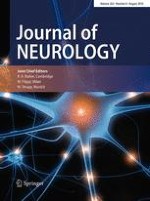Erschienen in:

23.05.2016 | Original Communication
Objective characterization of daily living transitions in patients with Parkinson’s disease using a single body-fixed sensor
verfasst von:
Hagar Bernad-Elazari, Talia Herman, Anat Mirelman, Eran Gazit, Nir Giladi, Jeffrey M. Hausdorff
Erschienen in:
Journal of Neurology
|
Ausgabe 8/2016
Einloggen, um Zugang zu erhalten
Abstract
Body-fixed sensors (BFS), e.g., accelerometers worn for several days, can be used to augment the traditional clinical assessment. Long-term recordings obtained with BFS have been applied to study tremor, postural control, freezing of gait, turning abilities, motor response fluctuations and fall risk among older adults and patients with Parkinson’s disease (PD). We aimed to test whether BFS-derived measures of transitions differ between patients with PD and healthy controls, and to evaluate whether there are differences among patients with mild PD, compared to more severe patients, and to controls. We also explored the added value of the metrics extracted from the sensor as compared to traditional testing in the lab. Ninety-nine patients with PD and 38 healthy older adults (HOA) participated in this study and wore a body-fixed sensor for 3 days. Walk-to-sit (n = 3286) and Sit-to-walk (n = 2858) transitions were analyzed and a machine learning algorithm was applied to distinguish between the groups. Significant differences in transitions were observed between PD patients and HOA, between mild and severe PD, and between mild PD and HOA, both in temporal and distribution features. The machine learning algorithm discriminated patients from HOA (accuracy = 92.3 %), mild from severe patients (accuracy = 89.8 %), and mild patients from HOA (accuracy = 85.9 %). These initial results suggest that body-fixed sensor-derived metrics of everyday transitions can characterize disease severity and differentiate mild PD patients from healthy older adults. Perhaps this approach can help with the integration of BFS into clinical care and the tracking of disease progression and the response to therapy.